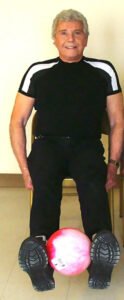By Deborah Jeanne Sergeant

You may love high-intensity interval training for its quick calorie blast. However, HIIT also provides benefits to your heart.
“I have no doubt that there are heart health benefits from HIIT,” said Joe Fox, personal trainer, certified functional strength training coach and owner of TrainSMART Personal Training in Buffalo. “The question is, ‘How do you define HIIT?’ And it comes down to strategy. Do people have the right program for them? Is it safe? Do they have a foundation for fitness and the right flexibility and mobility? Do they have high quality movement patterns so they’re moving more intensely and moving well so they get the benefits of heart health while staying safe? It’s very relative to the person.”
Of course, someone who’s sedentary should not engage in HIIT, as it’s pretty intense. HIIT involves working as hard as possible for 15 seconds at a physical movement, such as jumping jacks, riding a stationary bike or running on a treadmill and then taking a break for 10 seconds before engaging in a different activity. The times vary, depending upon the HIIT program. Some involve working hard for 30 seconds and rest for 30. The whole session could be as short as 15 to 20 minutes.
“Walking three flights of stairs could be a very valuable and appropriate part of a HIIT program for a certain person,” Fox said. “When you say, ‘Is it appropriate for that person,’ it depends on the skill of the person who designed the program. The rarest and best skill is assessment.”
HIIT is definitely a hit for time-crunched people who cannot cram in hour-long workouts into their schedules. But it may not be good for many people to work out with HIIT daily because of its intensity.
“It’s important to think about your own situation when deciding whether to do HIIT or steady state cardiovascular exercise,” said Kerri Howell, certified personal trainer, nutrition coach and owner of The Hourglass Mom in the Rochester area. “HIIT can be a big bang for your body’s buck, but it could come at the risk of injury. And if all you do are high-intensity workouts, you are only working on one component of cardiovascular conditioning, ignoring endurance.”
She added that HIIT may lead to burnout. She advised mixing up fitness with a combination of low-intensity, mid-intensity and high-intensity workouts throughout the week as time permits.
Austyn Affronti, president of Affronti Fitness in Rochester, also said that combining HIIT with other exercise routines provides the most benefit.
“HIIT should be interchangeable with your workout but not every day,” he said.
He added that in addition to cardiovascular benefits, the biggest plus of HIIT is its long-term calorie burn.
“What it does is create a massive demand for oxygen for cells,” he said. “It’s the post-exercise oxygen effect. For the next eight to nine hours, your cells are demanding extra oxygen so you’re burning calories long after the workout instead of during the workout.”
HIIT also doesn’t burn muscle as long bouts of cardio tends to do. So, “for muscle retention, it’s better,” Affronti said.
For older adults, engaging in HIIT depends upon person fitness and how high the person scales the intensity. Richard Derwald, fitness trainer consultant for Erie County Senior Services, warned people who don’t currently work out to ease into HIIT.
“It’s more aerobic than anaerobic,” he said. “You can control the number of reps and speed. If you’re in a group you might try to keep up with the group, which you don’t want to do if you’re out of shape or older.”

